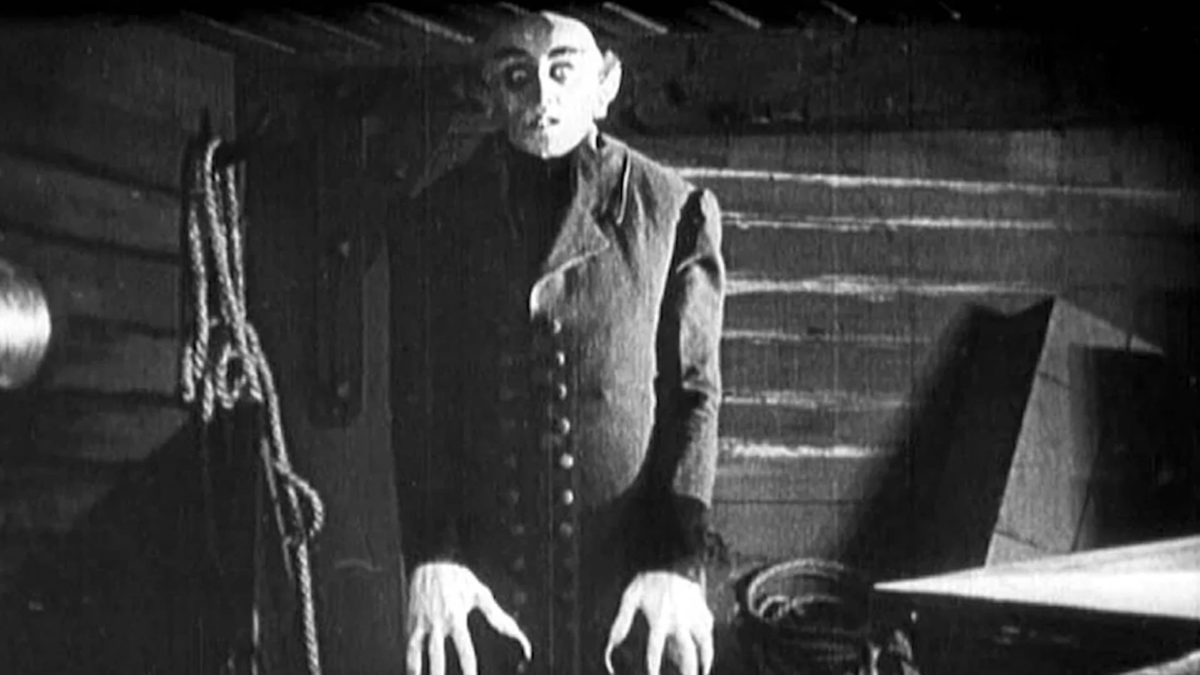F.W. Murnau’s Nosferatu is among the earliest horror films to be universally canonized, and it’s not hard to see why: A hundred years on and some of these scenes remain deeply unsettling nightmare fuel. Max Schreck as a towering, gaunt, rat-faced vampire is the unforgettable essence of unstoppable evil.
This is the third film in the 1001 Movies You Must See Before You Die list with roots in the German Expressionism movement, following The Cabinet of Dr. Caligari and Dr. Mabuse, the Gambler — no doctoral degrees for this title character this time around. Nosferatu is closer to Fritz Lang’s Dr. Mabuse in the sense that it’s an early work of a master with his own style but tinged with Expressionism, unlike Dr. Caligari, which is a pure example of the movement.
(Also like Dr. Mabuse, I watched with an excellent and informative commentary by David Kalat. I highly recommend it.)

Nosferatu is the first notable Dracula adaptation, keeping much of the plot but changing the name of the story and villain. There’s a famous story that Murnau wanted to skirt copyright law, so he simply changed the name to avoid having to get the rights. The story is half true: While Murnau did indeed flaunt copyright by using the source novel without licensing it, the name change wasn’t some misguided plan to avoid lawsuits or profit sharing. In fact, the movie’s second intertitle proudly announces that it’s based on Dracula by Bram Stoker! (And Murnau was indeed sued. The resulting lawsuit resulted in a court order to destroy all copies of the film; thankfully, some survived.) The truth is, nobody’s 100% sure today why the story was renamed to Nosferatu, the vampire renamed to Count Orlok, but it appears to be a creative choice, not a pragmatic one.
In the century since the movie was made, many people have wondered if Orlok is an anti-Semitic creation from interwar Germany; many of Orlok’s physical characteristics match anti-Semitic caricature and propaganda. Perhaps subconsciously that was an influence on Orlok’s design, but there’s a much more direct reason for his rodent-like appearance.
When Nosferatu was made, Germany was just a couple years past the deadly 1918 flu pandemic. Rodents were widely understood to be spreaders of disease. Murnau and his team explicitly link Orlok with both rats and death throughout the film, a connection that would have been viscerally threatening in the early 1920s. Viewed in this light, Nosferatu has an extra, apocalyptic layer of terror — his legion of vermin may bring the end of the entire community through pestilence.

Of course it’s a vampire story, so there’s plenty of shadowy creeping — some of the greatest and most iconic in cinema history, perhaps. Nosferatu amps up the sexual terror gradually throughout the film, but especially in the final few minutes as Orlok stalks and sucks the rosy life from Ellen Hutter with his sharp nighttime stabs. A hundred years later and it remains a tense and horrifying conclusion.
Unfortunately, other parts of the movie don’t quite hold up. The entire middle act is a draggy bit of narrative wheel-spinning as we wait for characters to relocate. There’s some bizarre B-roll from nature documentaries added in, and some impressive if ultimately inessential on-location ship footage.
And, as great as the movie’s overall look is, the stop-motion-esque, frame-skipping, jittery effect used when Orlok travels meant to show his magic powers looks painfully cheesy nowadays.
Still, Nosferatu is unquestionably an enduring achievement in horror, brilliantly marrying visuals and story and theme. Murnau’s eye for vivid and stirring compositions is abundantly clear, from the painterly landscape shots that add a mythic quality to the film to a handful of the creepiest moments ever shot on film as of 1922. We’ll be seeing Murnau on the 1001 Movies list again.
(I’m attempting to watch 1001 Films to See Before Your Die in chronological order. This is film number 15. Up next is cult horror essay film Häxan.)
Is It Good?
Very Good (6/8)
A few words on "Is It Good?" ratings for early cinema.
Dan is the founder and head critic of The Goods. Follow Dan on Letterboxd. Join the Discord for updates and discussion.

